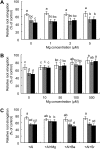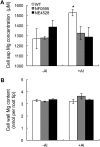Up-regulation of a magnesium transporter gene OsMGT1 is required for conferring aluminum tolerance in rice
- PMID: 22732245
- PMCID: PMC3425201
- DOI: 10.1104/pp.112.199778
Up-regulation of a magnesium transporter gene OsMGT1 is required for conferring aluminum tolerance in rice
Abstract
Magnesium (Mg)-mediated alleviation of aluminum (Al) toxicity has been observed in a number of plant species, but the mechanisms underlying the alleviation are still poorly understood. When a putative rice (Oryza sativa) Mg transporter gene, Oryza sativa MAGNESIUM TRANSPORTER1 (OsMGT1), was knocked out, the tolerance to Al, but not to cadmium and lanthanum, was decreased. However, this inhibition could be rescued by addition of 10 μm Mg, but not by the same concentration of barium or strontium. OsMGT1 was expressed in both the roots and shoots in the absence of Al, but the expression only in the roots was rapidly up-regulated by Al. Furthermore, the expression did not respond to low pH and other metals including cadmium and lanthanum, and was regulated by an Al-responsive transcription factor, AL RESISTANCE TRANSCRIPTION FACTOR1. An investigation of subcellular localization showed that OsMGT1 was localized to the plasma membrane. A short-term (30 min) uptake experiment with stable isotope (25)Mg showed that knockout of OsMGT1 resulted in decreased Mg uptake, but that the uptake in the wild type was enhanced by Al. Mg concentration in the cell sap of the root tips was also increased in the wild-type rice, but not in the knockout lines in the presence of Al. A microarray analysis showed that transcripts of genes related to stress were more up- and down-regulated in the knockout lines. Taken together, our results indicate that OsMGT1 is a transporter for Mg uptake in the roots and that up-regulation of this gene is required for conferring Al tolerance in rice by increasing Mg concentration in the cell.
Figures








References
-
- Beebe JA, Kurz JC, Fierke CA. (1996) Magnesium ions are required by Bacillus subtilis ribonuclease P RNA for both binding and cleaving precursor tRNAAsp. Biochemistry 35: 10493–10505 - PubMed
-
- Bose J, Babourina O, Rengel Z. (2011) Role of magnesium in alleviation of aluminium toxicity in plants. J Exp Bot 62: 2251–2264 - PubMed
-
- Cakmak I, Kirkby EA. (2008) Role of magnesium in carbon partitioning and alleviating photooxidative damage. Physiol Plant 133: 692–704 - PubMed
-
- Chen J, Li LG, Liu ZH, Yuan YJ, Guo LL, Mao DD, Tian LF, Chen LB, Luan S, Li DP. (2009) Magnesium transporter AtMGT9 is essential for pollen development in Arabidopsis. Cell Res 19: 887–898 - PubMed
Publication types
MeSH terms
Substances
Associated data
- Actions
LinkOut - more resources
Full Text Sources
Molecular Biology Databases
Miscellaneous

